Hey, guys, today we are going to talk about a wonderful city in Tuscany. I am going to walk you through the top places of Siena. We are offering a guide, which covers the major attractions of the city. However, always feel free to improvise 😉.
Let’s go!
See Siena in a day:
Quick Facts
Siena is the capital of its province and a town in the center of Tuscany. Like many other Tuscan hilly towns, it started as an Etruscan settlement dating back to 900 BC.
The Republic of Siena was formed in the Middle Ages and existed for 400 years until it ended when it was taken over by the Spanish crown supported by Florence in the mid-16th century. It then became a part of The Grand Duchy of Tuscany ruled by the Florentine noble family of Medici. With the death of the last Medici, Siena, as a part of the Grand Duchy, passed into the hands of the Austrian Empire in the mid-18th century. Finally, after the Napoleonic period, the city of Siena voted to become a part of the Kingdom of Italy in the mid-19th century.
What is Siena Famous For?
- Siena was one of the most important cities in Europe in medieval times. The city is famous for its art and cuisine. The historic center of the city with its 13th and 14th-century buildings is part of the UNESCO World Heritage List.
- Twice a year, the city holds a unique horse racing competition, Palio, in Piazza Campo – the central square of Siena.
- The University of Siena is one of the oldest universities in the world, dating back to 1240.
- The Siena Monte dei Paschi bank is the oldest operating bank in the world, active since 1472.
Itinerary
Starting our journey in Bologna, we took a morning train to Arezzo, an eastern Tuscany town at the border with Umbria. My Italian friend from the Marche region picked us up in a car, and from there, we headed to Siena.
We combined the trip to Siena with visits to local wineries and a day in Arezzo. Our first day in Tuscany was spent in Siena.
We booked rooms in a cozy villa, a family-owned hotel a bit outside the city center of Siena. Since the next day was dedicated to wineries, we needed to be well-rested. Even though the hotel is outside of the center, considering the size of the city, the distances are modest. You can easily reach the city center from here by bus within 15 minutes. A suitable bus route and a bus stop can be found on Google Maps. It is much easier if you’re renting a car, but we would recommend parking it outside the city center. We left ours at the hotel.
1. Medici Fortress
Italian: Fortezza Medicea

As we entered the city, we started exploring magnificent Siena from the Medici Fortress. The Fortress is located on the northern edge of the city. It’s a medieval edifice built in the mid-16th century on the orders of the First Duke of Tuscany, Cosimo of the Medici family.
These days, this historical structure has been transformed into a public park and is frequently used to host events and exhibitions. It’s also home to the Siena Jazz Foundation. The Fortress is a great starting point for Siena, especially when entering the city center from the north. From its top, you can enjoy a beautiful panorama of the city.
Opening hours: 24/7
Ticket price: free
2. Basilica of San Domenico
Italian: Basilica Cateriniana
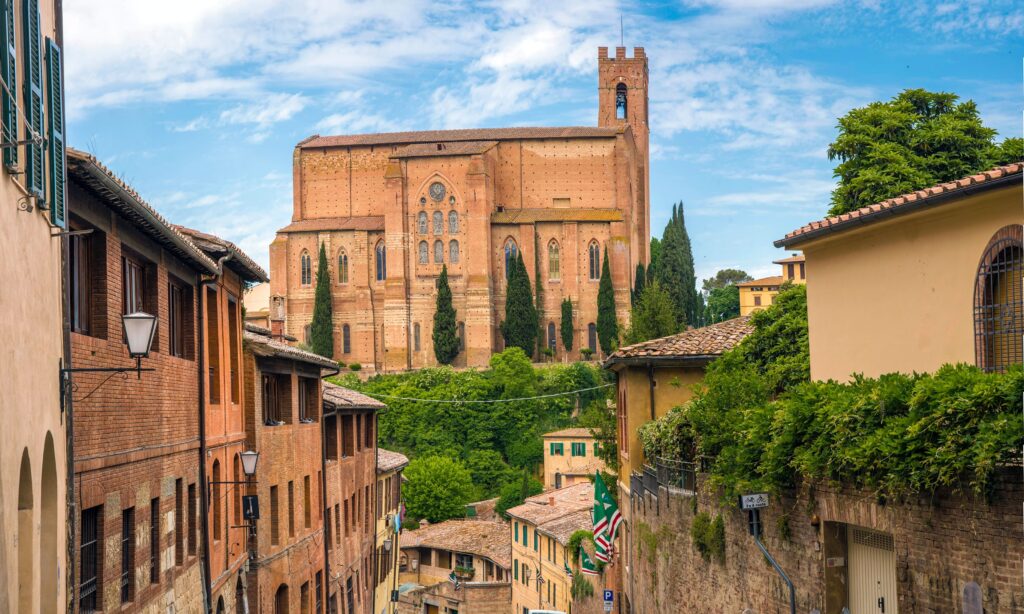
Just a 10-minute walk from the Medici Fortress is located the magnificent Basilica Cateriniana, one of the most important Catholic churches in Siena. This Gothic basilica dates back to the mid-13th century and houses several relics of St. Catherine of Siena, such as The Holy Head of St. Catherine.
St. Catherine was a mystic and author of religious scripts who had a significant influence on Italian literature and the Catholic Church. St. Catherine was canonized in 1461.
This unique church is definitely worth visiting to view the frescoed chapels, religious artwork from the 15th and 16th centuries, and simply to embrace its tranquility.
Opening hours: 7:30 AM – 6:30 PM
Ticket price: free
3. Sanctuary of St. Catherine
Italian: Santuario Casa di Santa Caterina
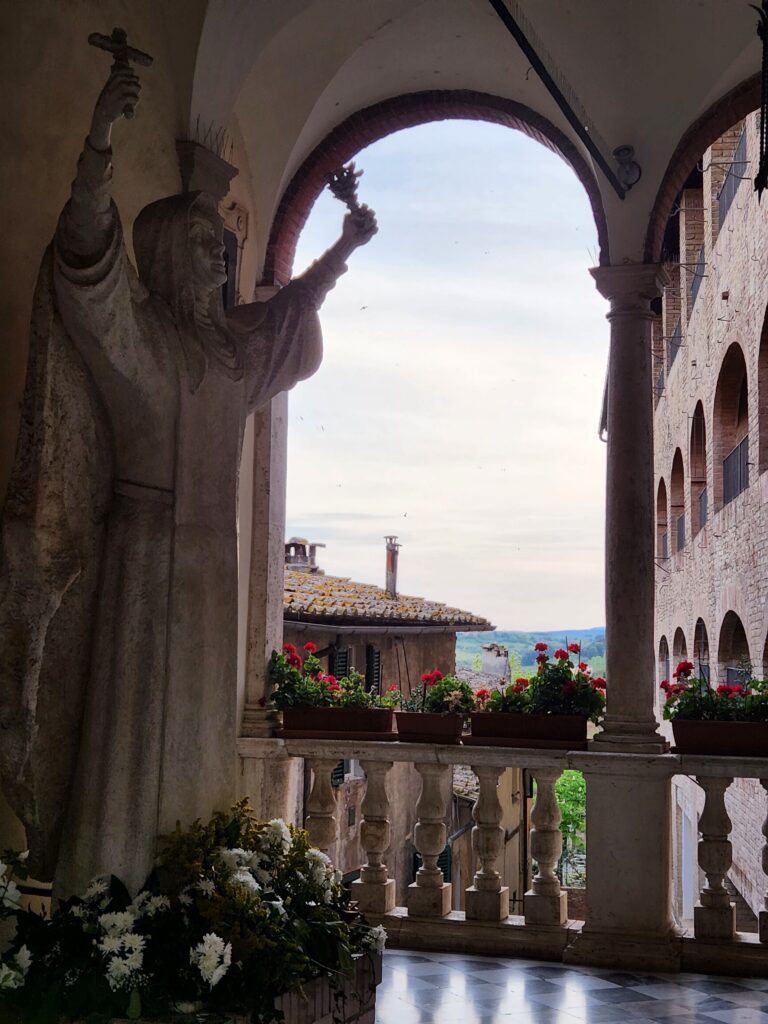
About 5 minutes away from Basilica Cateriniana, there is the Sanctuary of the Saint.
The Sanctuary of St. Catherine is essentially a complex of buildings, which includes the former house of Catherine’s family, the Benincasa family – the birthplace of the Saint. The complex consists of various porticoes, loggias, churches, and oratories from different epochs. Access to the Sanctuary is made through the Portico dei Comuni d’Italia.
The place is considered to be the most representative of St. Catherine’s life. Belonging to the Third Order of Saint Dominic (a part of the Dominican Order), she continued living in her family house.
You may wonder how it was possible for a member of a religious order to live in her own house rather than a convent. The Third Order offered such a possibility – a possibility of living the faith in the world. St. Catherine’s example was rather particular; living her life “in the world” rather than in a convent makes her a lay sister rather than a nun, which did not keep her from living a deeply spiritual life.
Opening hours: 9 AM – 5:30 PM
Ticket price: free
At this point, you might already be a little bit tired, but we are about to reach the most important attraction of our tour in Siena – the magnificent Siena Cathedral! And then, I promise, we’ll have lunch.
4. Siena Cathedral
Italian: Duomo di Siena
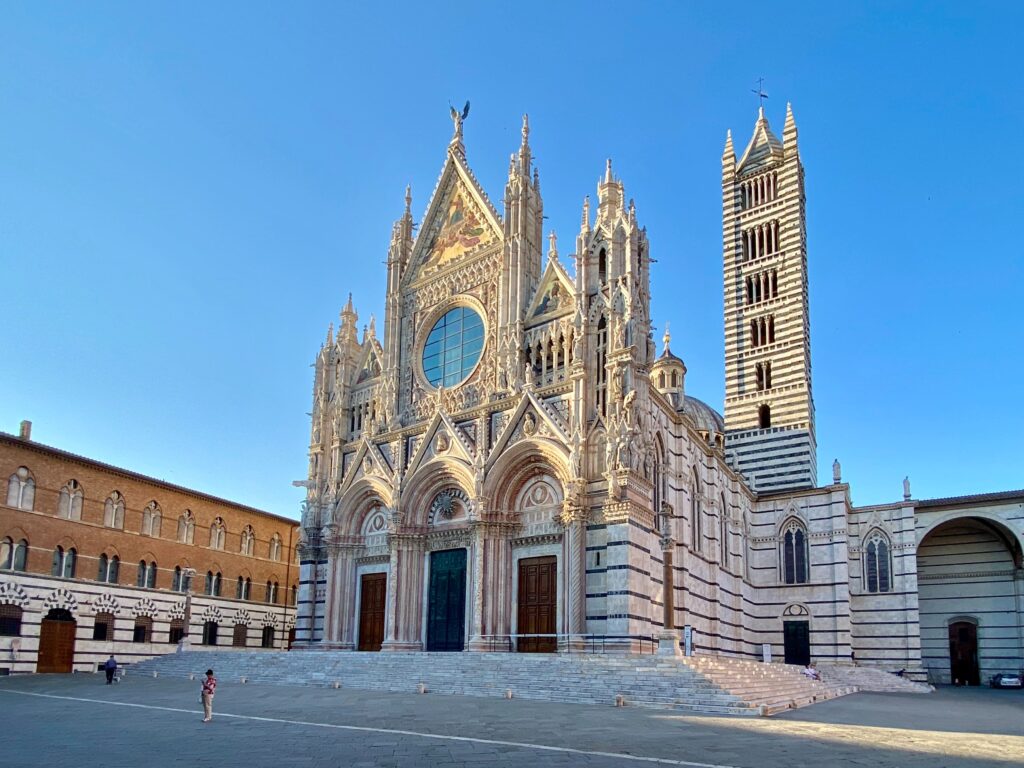
And within a 5-minute walking distance (this is what I like about Siena – almost everything is 5 minutes away), you’ll see the masterpiece of Italian Romanesque-Gothic architecture – the gorgeous Duomo of Siena.
I don’t even want to write anything here. Just go and see it.
The church’s story began in the 12th century; however, the facade was completed in 1380. It accommodates the works of the finest Italian artists of that era, such as Nicola and Giovanni Pisano, Donatello, Pinturicchio, Lorenzo Ghiberti, and Bernini.
Adjoining the cathedral is the Piccolomini Library, which is a must-visit place for precious illuminated choir books and magnificent frescoes painted by Bernardino di Betto.
I would recommend buying a ticket in advance as everything might be sold out on the same day. The price varies depending on the season from 13 to 20 Euro. The ticket grants you access to the roof of the Cathedral and to all of the sites included in the monumental complex.
Opening hours:
- From April 1 to October 31: 10:00 am – 07:00 pm (9:30 am – 7:30 pm Opera Museum). Cathedral, Sundays, and public holidays: 1:30 pm – 6:00 pm
- From November 1 to March 31: 10:30 am – 5:30 pm. Cathedral, Sundays, and public holidays: 1:30 pm – 5:30 pm
- From December 26 to January 6: 10:30 am – 6:00 pm. Cathedral, Sundays, and public holidays: 1:30 pm – 5:30 pm. Cathedral, Saturdays, and eve of public holidays: 10:30 am – 5:30 pm
- From June 27 to July 31 and from August 18 to October 17, 2022: 10:00 am – 07:00 am (9:30 am – 7:30 pm Opera Museum). Cathedral, Sundays, and public holidays: 9:30 am – 6:00 pm
Ticket price: from 13 to 20 Euros
For guided tours, contact in advance: tel: +39 0577 286300, opasiena@operalaboratori.com
5. Lunch: Ristorante Numero Unico
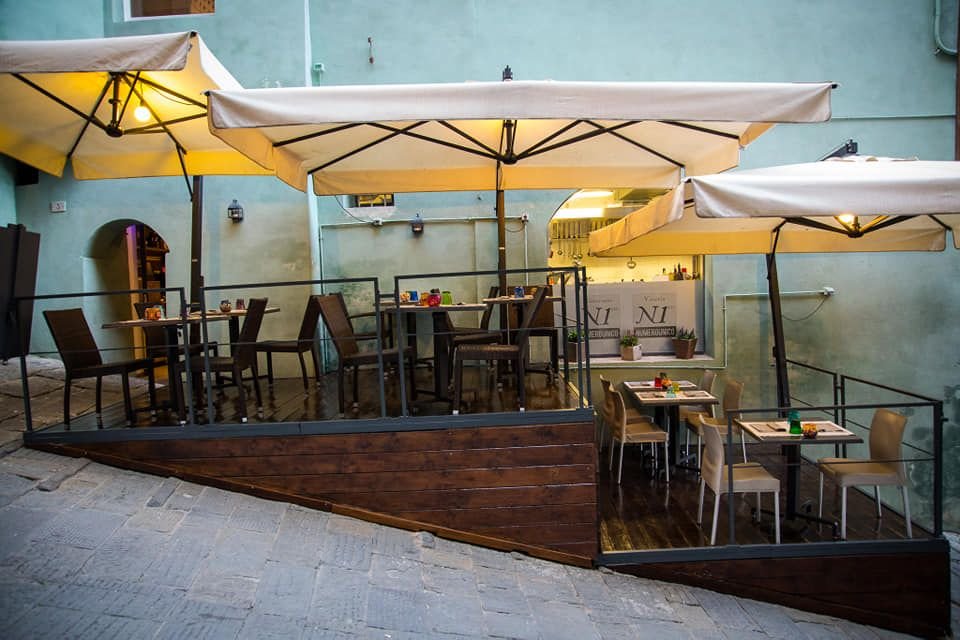
Yeah, you deserved it! Finally, just 3 minutes away from the Duomo, there is a nice restaurant called Numero Unico with typical Tuscan food. I would personally recommend the pasta Pappardelle with wild boar ragu (Italian: Pappardelle al ragu’ di cinghiale) and sliced beef steak with rosemary potatoes (Italian: Tagliata di Manzo con patate al rosmarino).
What wine? Obviously, Chianti – the wine Tuscany is famous for! But don’t hesitate to order the house wine. It is really good in most of the places. But before ordering, you can always ask to taste it just to make sure that you like it. Buon appetito!
Don’t forget to reserve a table in advance, as the place might be packed!
6. Pinacoteca Nazionale
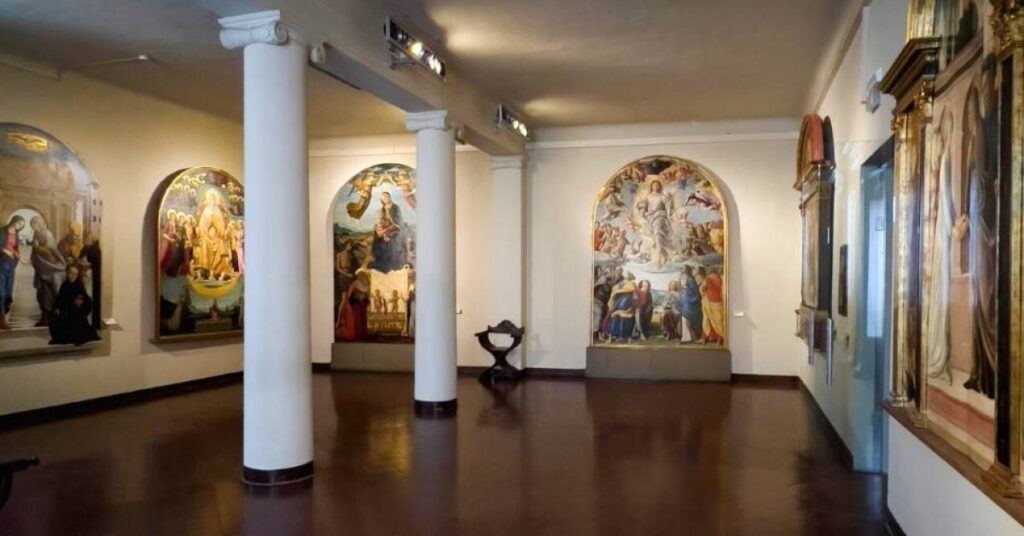
Guess what? Just 3 minutes away from the restaurant, you’ll find the national museum of Siena – Pinacoteca Nazionale. It houses late medieval and Renaissance paintings by Italian artists.
Here you can find the works of Duccio di Buoninsegna, Guido da Siena, Simone Martini, Ambrogio Lorenzetti, Bartolo di Fredi, Michelino da Besozzo.
Personally, I am not a fan of religious art, except for architectural monuments, so I skipped it. But if you want to see the largest collections of Sienese paintings with backgrounds of the golden era of Siena from the 14th and 15th centuries, you should definitely go.
Opening hours: Monday 9:00-13:30, Tuesday – Saturday: 09:00-19:00, Sunday: 9:00-13:30, Public holidays: 9:00-13:30.Ticket price: 6 Euro
7. Piazza del Campo (square)

And finally, in just a few steps from Pinacoteca, we are in the heart of the town, at Piazza del Campo.
Piazza del Campo is the main square of Siena and its historic center. It is considered to be one of Europe’s greatest medieval squares. It has a very particular shape – the shape of a shell, surrounded by The Palazzo Pubblico and its Torre del Mangia, as well as by other various palaces.
Twice a year, on the 2nd of July and the 16th of August, a unique horse race is held at the Piazza. It is called the Palio. It is a competition of ten bareback horse riders, dressed in different colors, representing seventeen out of 10 contrades, or city wards. The race is run for three laps, lasting not more than 90 seconds around the piazza. It is common for several horse riders to be thrown off their horses. However, a horse without a jockey can still win a race, even reaching the finishing line without a rider. I didn’t get a chance to see the race, but I would definitely return to Siena for it.
8. Palazzo Pubblico
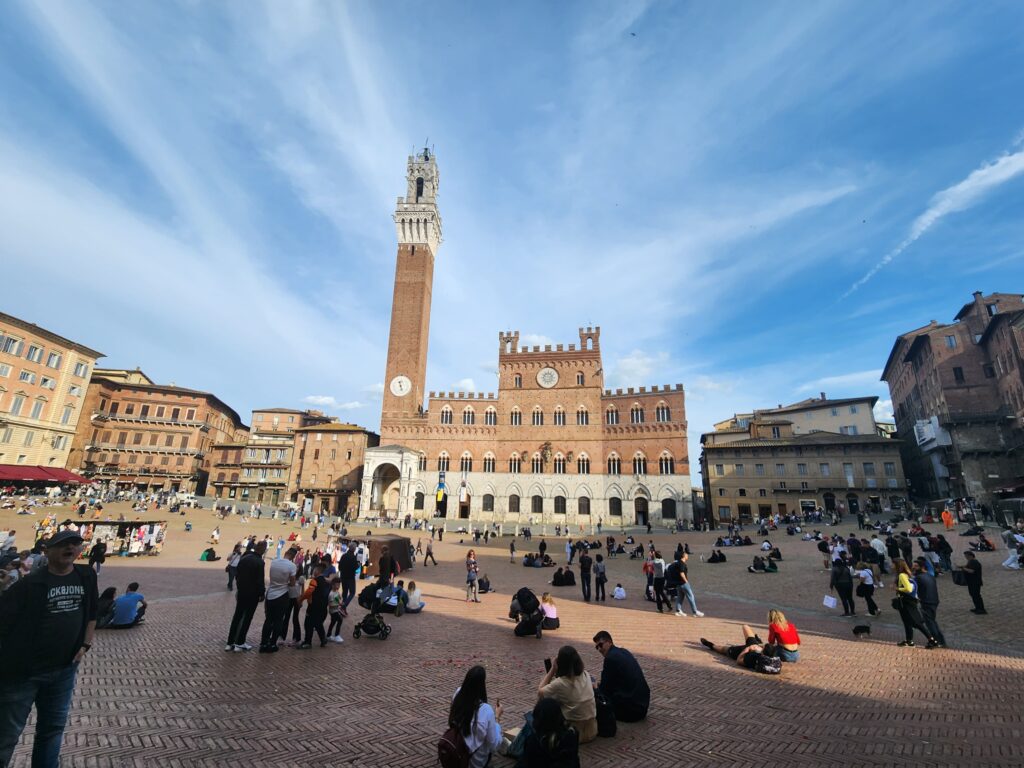
The Palazzo Pubblico is essentially the town hall overlooking the Piazza del Campo. It was built to serve as the seat of the government of the Republic of Siena. Its construction began in 1297.
Nearly every major room in the palace contains frescoes. You can access a part of the Palace, which is occupied by Museo Civico di Siena. The museum showcases rooms richly frescoed by artists of the Sienese school. Some of the frescoes depict non-religious scenes and subjects, which was unusual at the time.
While visiting the Palazzo Pubblico, it is definitely worth climbing the 87-meter-high tower Torre del Mangia to enjoy the town’s panorama.
Entrance: Essentially, you can buy the tickets online in advance from the website of the Siena Commune. However, the website is not super user-friendly, and even though there is an English version of the website, opting for that doesn’t change anything, and everything remains in Italian :). Alternatively, you can buy the tickets in advance here. Or buy the tickets at the venue itself. See the below timetable and the prices:
Opening hours: From 01.11 to 28.02: 10 AM – 6 PM (ticket office closes at 5:15 PM) Christmas: closed New Year: 12 PM – 6 PM (ticket office closes at 5:15 PM) From 01.03 to 31.10: 10 AM – 7 PM (ticket office closes at 6:15 PM).
Ticket price: € 6,00
Note: During the Palio horse race (02.07 and 16.08), the venue is closed, and several days before the race, the schedule might be affected.
The Siena Comune offers the combined tickets as well for Museo Civico, Santa Maria della Scala, Torre del Mangia, Pinacoteca Nazionale di Siena.
9. Aperitif
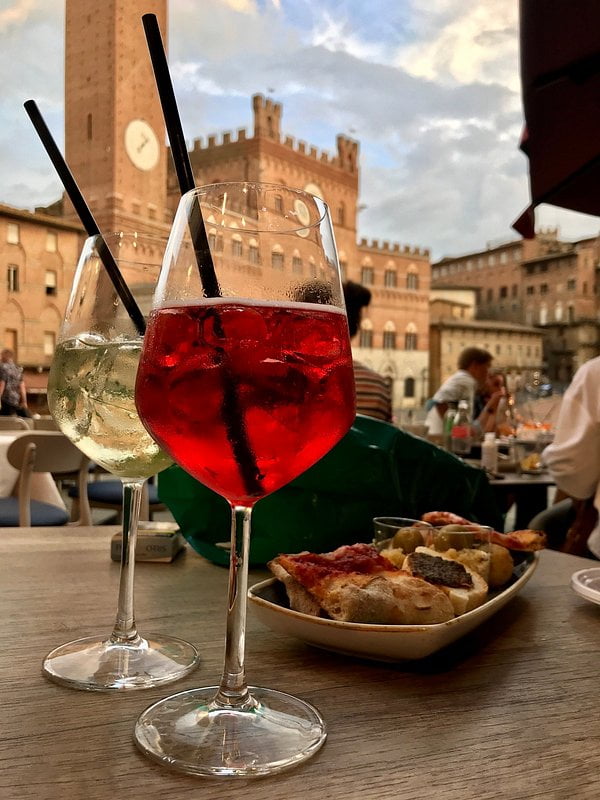
It is past 6 PM, and after visiting the Palazzo Pubblico and Torre del Mangia, we are a bit tired and thirsty 😉. So let’s follow the Italian tradition and have an aperitivo break here at Piazza del Campo. Moreover, it is still early for dinner, as Italians usually have it late, at around 8 PM. But a usual reminder: don’t forget to reserve a table in advance!
There are many bars and restaurants around the square for you to choose from. We sat outside at Gran Caffè Siena, overlooking the Piazza, with a glass of Campari spritz.
10. Dinner: Grotta Santa Caterina da Bagoga
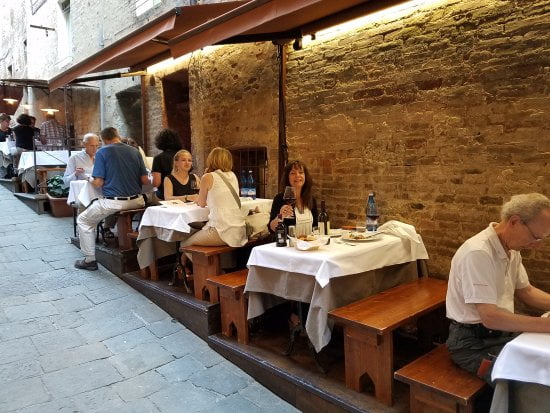
We reached the culmination of our day in Siena, and obviously for dinner, we chose a typical Tuscan restaurant – Grotta Santa Caterina da Bagoga, which is (guess how many minutes away?) exactly, 5 minutes away from Piazza del Campo.
It is a wine cellar-style restaurant. Being a meat lover, I obviously went for a Tuscan steak. If you are not afraid of a cholesterol burst, go for Filetto Di Maiale Con Lardo (pork fillet with lard), obviously paired with a few glasses of Chianti. I love this dish. If you prefer to have your dinner light, you can opt for Tuscan truffle pasta. Anyway, I’ll find your option there. Buon appetito!
Transport and Moving Around
You can reach Siena by train:
Florence – around 1.5 hours
From Rome – around 3.5 hours
If you prefer to move around in a rented car, we would recommend parking it somewhere outside the city center and moving on foot.
Tips
Whenever you go to a restaurant in Siena or anywhere else in Italy, don’t hesitate to order house wine. It is cheap and in most cases, of great quality and taste. However, before ordering half a liter, just ask to try it and make sure that you like it.
Summary
We spent only one day in Siena as the next morning we were going on our winery tour, driving deeper into the land of Tuscany. It is totally worth spending a night in Siena and spending another day here, covering the remaining beautiful sites of the town:
Complesso Museale di Santa Maria della Scala: you can easily spend half a day here. A 13th-century civic hospital dedicated to caring for orphans, the poor, the sick, and pilgrims. It features 15th-century frescoes by Lorenzo di Pietro, hosts the National Archaeological Museum In the basement tunnels and the Old Chapel (Sagrestia Vecchia).
Palazzo Chigi-Saracini: a Gothic palace on the Via di Città. It was built by the Marescotti family in the 12th century and was acquired by the powerful Saracini family in the 18th century. Today it houses the Fondazione Accademia Musicale Chigiana. The attractions of the Palace include the Rococo concert hall, and the dining room decorated with paintings produced between the 13th and 18th centuries.
The palace accommodates valuable pieces of art, furniture, and antique musical instruments. The only way to visit the entire palace is to join a one-hour guided tour or attend a concert.
It is essential to book in advance by email or telephone: Tel. +39 0577 22091, accademia.chigiana@chigiana.it.
We hope that after having read this guide you are not puzzled any more about what to do in Siena. We tried our best to cover the major attractions of Siena. What’s left? Just pack your luggage and fly over here to see all the beauty with your own eyes!
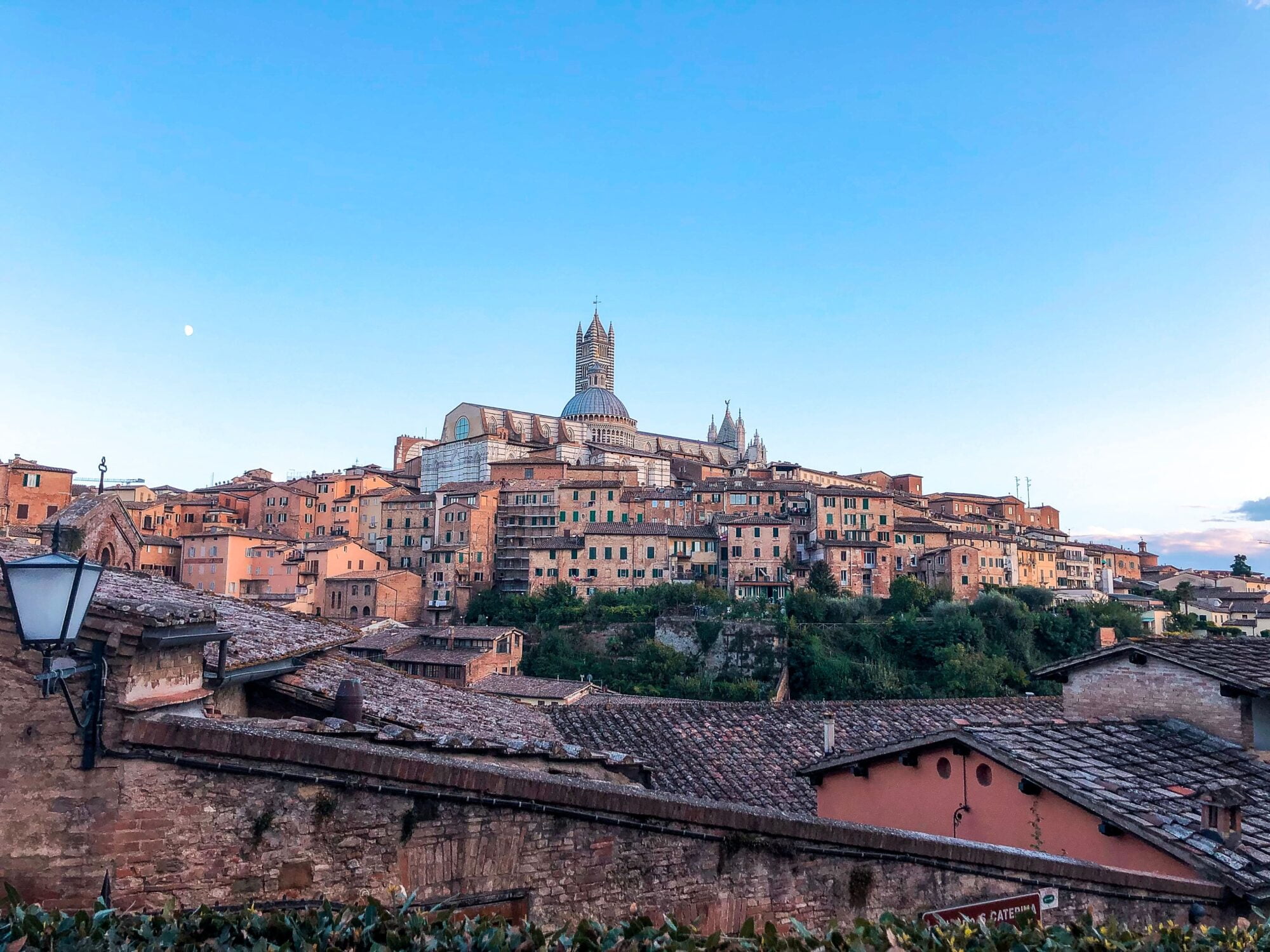
Pingback:3-day itinerary in the Chianti Region in Tuscany: Day 2 - MoreCappuccino
Pingback:3-day itinerary in the Chianti Region in Tuscany: Day 1 - MoreCappuccino